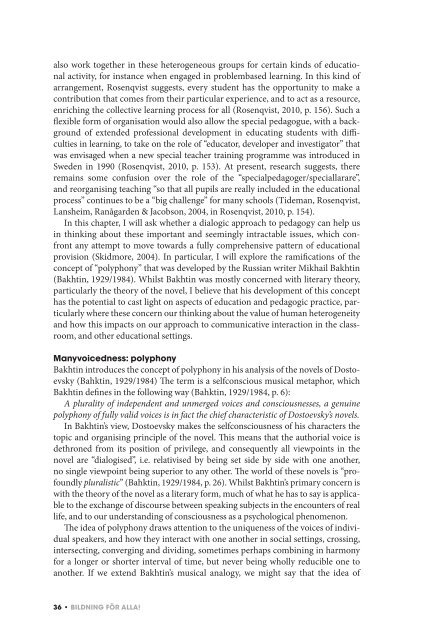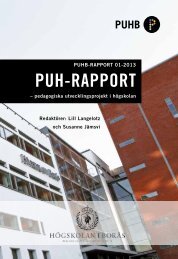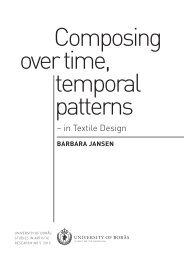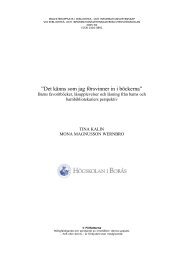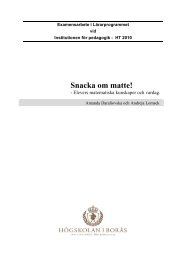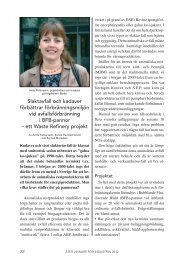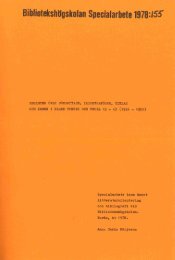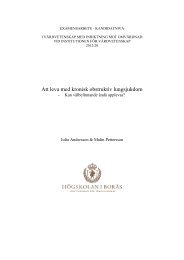Bildning för alla! - DiVA
Bildning för alla! - DiVA
Bildning för alla! - DiVA
You also want an ePaper? Increase the reach of your titles
YUMPU automatically turns print PDFs into web optimized ePapers that Google loves.
also work together in these heterogeneous groups for certain kinds of educational<br />
activity, for instance when engaged in problembased learning. In this kind of<br />
arrangement, Rosenqvist suggests, every student has the opportunity to make a<br />
contribution that comes from their particular experience, and to act as a resource,<br />
enriching the collective learning process for all (Rosenqvist, 2010, p. 156). Such a<br />
flexible form of organisation would also allow the special pedagogue, with a background<br />
of extended professional development in educating students with difficulties<br />
in learning, to take on the role of “educator, developer and investigator” that<br />
was envisaged when a new special teacher training programme was introduced in<br />
Sweden in 1990 (Rosenqvist, 2010, p. 153). At present, research suggests, there<br />
remains some confusion over the role of the “specialpedagoger/speci<strong>alla</strong>rare”,<br />
and reorganising teaching “so that all pupils are really included in the educational<br />
process” continues to be a “big challenge” for many schools (Tideman, Rosenqvist,<br />
Lansheim, Ranågarden & Jacobson, 2004, in Rosenqvist, 2010, p. 154).<br />
In this chapter, I will ask whether a dialogic approach to pedagogy can help us<br />
in thinking about these important and seemingly intractable issues, which confront<br />
any attempt to move towards a fully comprehensive pattern of educational<br />
provision (Skidmore, 2004). In particular, I will explore the ramifications of the<br />
concept of “polyphony” that was developed by the Russian writer Mikhail Bakhtin<br />
(Bakhtin, 1929/1984). Whilst Bakhtin was mostly concerned with literary theory,<br />
particularly the theory of the novel, I believe that his development of this concept<br />
has the potential to cast light on aspects of education and pedagogic practice, particularly<br />
where these concern our thinking about the value of human heterogeneity<br />
and how this impacts on our approach to communicative interaction in the classroom,<br />
and other educational settings.<br />
Manyvoicedness: polyphony<br />
Bakhtin introduces the concept of polyphony in his analysis of the novels of Dostoevsky<br />
(Bahktin, 1929/1984) The term is a selfconscious musical metaphor, which<br />
Bakhtin defines in the following way (Bahktin, 1929/1984, p. 6):<br />
A plurality of independent and unmerged voices and consciousnesses, a genuine<br />
polyphony of fully valid voices is in fact the chief characteristic of Dostoevsky’s novels.<br />
In Bakhtin’s view, Dostoevsky makes the selfconsciousness of his characters the<br />
topic and organising principle of the novel. This means that the authorial voice is<br />
dethroned from its position of privilege, and consequently all viewpoints in the<br />
novel are “dialogised”, i.e. relativised by being set side by side with one another,<br />
no single viewpoint being superior to any other. The world of these novels is “profoundly<br />
pluralistic” (Bahktin, 1929/1984, p. 26). Whilst Bakhtin’s primary concern is<br />
with the theory of the novel as a literary form, much of what he has to say is applicable<br />
to the exchange of discourse between speaking subjects in the encounters of real<br />
life, and to our understanding of consciousness as a psychological phenomenon.<br />
The idea of polyphony draws attention to the uniqueness of the voices of individual<br />
speakers, and how they interact with one another in social settings, crossing,<br />
intersecting, converging and dividing, sometimes perhaps combining in harmony<br />
for a longer or shorter interval of time, but never being wholly reducible one to<br />
another. If we extend Bakhtin’s musical analogy, we might say that the idea of<br />
36 • BilDning fÖr AllA!


